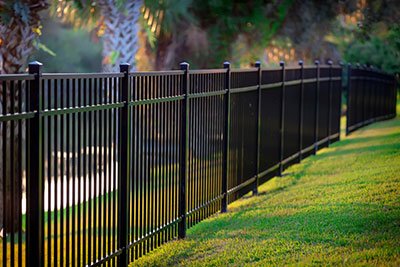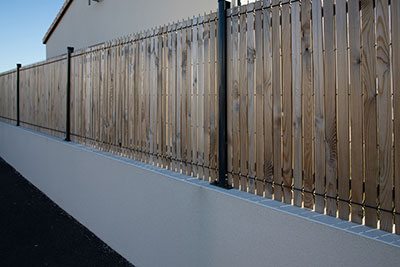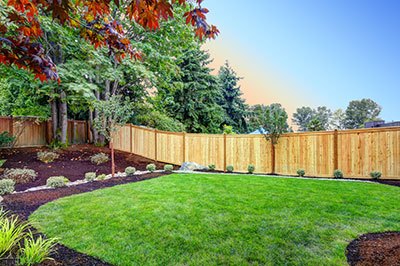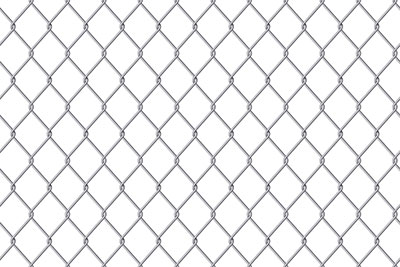If you’re looking for a way to protect your large property, fencing is the perfect solution.
We’ll walk you through the fencing solutions for large properties – from wood panels or plank fencing to metal barriers.
We’ll discuss each type of fence, and their estimated costs to choose the best solution. So, let’s dive in!
Take away key points:
- Choosing the best fencing type is necessary to keep your large property lines optimal
- Find different materials and fencing types to ensure the best standards and keep intruders away. These include picket fencing, game fencing, garden fencing, wood, split cedar fencing, smooth galvanized wire fencing, etc.
- Learn how to install them – maybe you need the fencing company to assemble them
Table of Contents
If you need the best fence for large property, but don’t know where to start, what fencing materials to choose, and what fencing options to look for, read our guide below.
We will explain all you need to know about the best fencing for private property in rural areas.
Do you need a fence for a rural property?

If you own a rural property, you may be wondering whether or not you need a fence. The answer is yes! Fencing offers a range of benefits that make it essential for any rural property owner.
Fences can help contain large animals like cows, horses, and sheep, preventing them from wandering off your large property. They can also protect your crops and gardens from pests and wildlife.
Additionally, fencing can improve the aesthetics of your large property and mark your rural property lines.
Best fence materials for your large property lines
Choosing the right fence material can have an impact on the cost, longevity, and maintenance required. Therefore, we will discuss the pros and cons of popular fencing materials and fencing styles to help you make an informed decision for your fencing project for larger properties.
1. Vinyl fences
Vinyl fences are lower-maintaining options, requiring less upkeep than wooden fences. They are available in several styles including:
– picket fences,
– privacy fences,
– semi-privacy fences,
– lattice fences,
– rail fences,
– woven fences,
– faux wood fences,
– faux masonry fences. They are similar to those found in wooden posts.
Vinyl fences are fire-resistant, splinter-free, and long-lasting, making them ideal for households with children. They are also available in a range of colors. With a lengthy fence line for larger properties, choosing a low-maintenance material like vinyl can save a considerable amount of time.
However, despite these benefits, not everyone uses vinyl. The new fence is more expensive to install than wood, and once manufactured, it is less customizable, harder to fix, and not eco-friendly. The cost of vinyl fence styles for large properties ranges between $17 and $38 per linear foot.
2. Wooden fences
Wooden fences are the most popular fencing option. These fencing materials are relatively cost-effective depending on the type of wood used. Keeping costs down when covering a large property is crucial.
These privacy fences provide a natural look that matches almost any style, and you can paint them any color you want. Some of the available styles include:
– picket fences,
– privacy fences,
– semi-privacy fences,
– rail fences,
– lattice fences,
– woven fences.
However, wooden fences for large properties need regular maintenance. The privacy fences are prone to damage from the elements and pests such as termites.
To extend the lifespan of the large property fence, use treated or rot-resistant wood and re-stain or repaint every few years. The cost of wooden fences ranges from $14 to $31 per linear foot.

3. Masonry fences
This option offers a unique look, and it’s a beautiful fence style. It includes contemporary designs using concrete and more classic styles featuring brick or stone. While masonry fences are popular for privacy reasons, many homeowners incorporate masonry pillars with other materials to create more variety.
Remember – once a masonry fence is installed, it’s tricky to remove this fencing option. While they generally don’t require much maintenance, fixing them up when they become worn is challenging in your back or front yard.
Maintenance includes inspecting for moss, mildew, mold, and holes annually. Living in areas that are prone to earthquakes is not ideal for these fences because they can easily break or fall apart in your large yards.
However, masonry fences can be costly, ranging from $10-$80 per square foot. They’re generally best suited for high-budget projects or small installations in your property line.
4. Composite fences
If you can’t decide between wood and vinyl fencing for a large yard, consider composite fencing. It has the benefits of both!
It’s made from recycled materials, making it an eco-friendly large yard option that’s low-maintenance, long-lasting, and resistant to pests and decay.
You can choose from various designs like picket, privacy, and lattice fences as well as faux wood and faux stone fences. However, composite fencing can be pricier than wood or vinyl to fence a large project.
So, if you’re on a tight budget, this fencing type may not be the best fit for you. The cost of composite fencing is generally between $26 to $57 per linear foot.
5. Metal fences
If you want a sturdy metal fence, steel, aluminum or iron are fantastic choices, all offering a wide array of fence types. Below are the most commonly used metal fences:
– Wire fences
– Wrought iron fences.
Metal fences are generally strong and can last for extended periods with low maintenance, but it’s essential to maintain these fences by using rust-resistant metal to improve their lifespan.
If you’re looking for affordability, chain-link, and wire fences are cheap farm fencing ideas. But, if you want something fancier, aluminum and wrought iron fences could come with a hefty price tag.
You can also find various galvanized wiring models, welded wire, woven wire, steel posts, wire mesh, steel rails, metal posts, etc. for different prices to fence a large unit.
Despite many metal fences being high in visibility, you can add slats to chain-link fences to make them private. It’s easier to repair chain-link fences than aluminum or wrought iron options, which require the assistance of a professional fencing company.
Price points:
– Aluminum fencing: $19-76 per linear foot
– Chain-link fencing: $12-$33 per linear foot
– Wire fencing: $1-$4 per linear foot
– Wrought iron fencing: $26-$34 per linear foot
6. Wrought iron fences
Expansive properties, including large estates, are frequently adorned with ornamental wrought iron fences. In the past, such fences were exclusive to the upper echelon of society.
However, these days, they are accessible to any property owner. Wrought iron fences are beautifully crafted, and installing one on your property immediately adds an air of sophistication. This type of fence can be a particularly attractive option when placed around historic and sprawling estates.
7. Barbed wire fence
Barbed wire fencing is one of the most popular and commonly used types of fencing for large properties. The razor wire is the most budget-friendly option and offers the flexibility to adjust the barbed wire’s spacing based on your preferences.
This fencing type is ideal for perimeter fencing (horse fencing and horse paddocks) and cattle pastures. If you’re wondering how to fence a large property, this option is worth considering.
However, a significant disadvantage of barbed wire fencing is the animals’ risk of getting injured due to the wire gauges. You must not turn your barbed wire fences into electric fence styles for rural properties, since your animals can suffer fatal consequences. The electric shock will hit them while trying to escape from the barbed wire trap.
Although this is a good alternative for your livestock fencing, as this fencing style requires minimal maintenance, you must check the local regulations before you start fencing. And you must pay special attention to your grazing paddocks inside your property lines since this fencing method can hurt your animals.
8. Living fences
If you’re looking for an aesthetically pleasing way to create a border around your property line, consider using plants. From privacy hedges to shrubs, a thick and dense vegetation border can add beauty and block unwanted sounds and sights. However, it may not be the best option if you’re looking to contain animals or children.
Living fences require the same maintenance as any plant, but they can last longer than traditional fences. You can combine a living fence with a traditional one to create extra privacy and security around your property.
The cost of living fences depends primarily on the plants you choose and your local climate. Visiting your local nursery can help you determine which plants will best suit your project and how much maintenance you need.
9. Bamboo fences
If you’re looking for something unique and exciting, bamboo fencing might just be the thing to spice up your property. There are two primary ways to install bamboo fencing:
– Grow live bamboo: This option is time-consuming but creates a beautiful living fence. However, bamboo is not easy to control.
– Use a bamboo fence roll: This is the most common method found in home improvement stores. Attach the roll to fence posts or insert it into metal frames to make panels, or attach it to an existing fence.
Bamboo fence panels can either be manmade structures by attaching bamboo to a wooden frame or purchased pre-made. However, rolls are easier to find than panels.
Bamboo panels and rolls are relatively inexpensive and simple to install, making them perfect for large spaces. Bamboo fencing provides almost complete privacy, although you may see some shapes, movement, and light through them.
Their suitability for security depends on how sturdy the bamboo is, but many bamboo fences are capable of keeping pets in. You have many style options to pick from, including: picket, privacy, semi-privacy, lattice, rail, and woven fences.
The cost of bamboo fencing generally ranges between $3 to $6 per linear foot.
Crucial factors to consider for fencing large yards
Here are important factors to consider when you must fence a large yard:
1. Purpose of your fence

You need to know the exact purpose of the fence to choose the best size, shape, and materials.
Whether it is game fencing, garden fence, plank fencing, split cedar fencing, chain link, etc. will depend on your needs.
2. Landscape
If your property has a natural slope, fencing can become quite challenging.
The best fencing materials to use in such situations are wood, aluminum, chain-link, or vinyl since they can accommodate the land’s shape. You’ll also need to remove any vegetation or rocks that stand in the way of the fence’s path.
3. Climate
As time goes on, all fencing materials will eventually degrade, and the cost of repairs can quickly add up, especially if you have a lot of fencing on your property.
It’s crucial to consider your local climate before choosing a fence. This includes taking into account factors such as temperature, precipitation, air salinity, and wind. You must choose fences to resist all harmful elements.
4. Durability
When you invest in a fence, there’s no need to worry about constantly having to maintain, repair, or replace it.
You’ll also want to make sure that the material used is capable of withstanding other elements such as kids and pets playing around and general wear and tear over time.
Opt for strong and durable materials for a longer-lasting fence.
5. Ease of installation & use
If you’re going to be doing the fencing yourself, make sure that you select a material that you can handle.
Wood and chain-link are generally easier for DIY projects, while masonry and wrought iron may require professional work. Even if you’re hiring someone to do the fence, it’s best to avoid labor-intensive materials, as the cost of all that labor will be passed on to you.
6. Maintenance
Think about the amount of work that goes into keeping your fence in its best condition. For instance, wood fences will require regular cleaning and refinishing, while vinyl just needs to be washed now and then.
Wooden pickets can be replaced one by one, but if a single panel of vinyl is damaged you’d need to replace the entire section. Consider how long each material will last before making a decision.
FAQs
How to fence 40 acres?
You will need four rolls of barbed wire as the cheapest fencing for acreage of 1/4 mile on each side.

How much fencing do I need for 1 acre?
To fence a large area of 1 acre, you need 835 linear feet of fence.
What is the cheapest way to fence 5 acres for horses?
An electric fence or rope is the cheapest way to do so.
How many fence posts for 1 acre?
You need 110 fence posts with a three-meter spacing.
Does having a fence increase property value?
Yes, having a fence is ideal for increasing the property value as it adds a beautiful appearance and privacy.
Summary
Having a fence around your large property plays a key role in increasing the value of your household. It adds privacy and keeps intruders away from your property. Depending on your needs, you can choose different fence styles.

